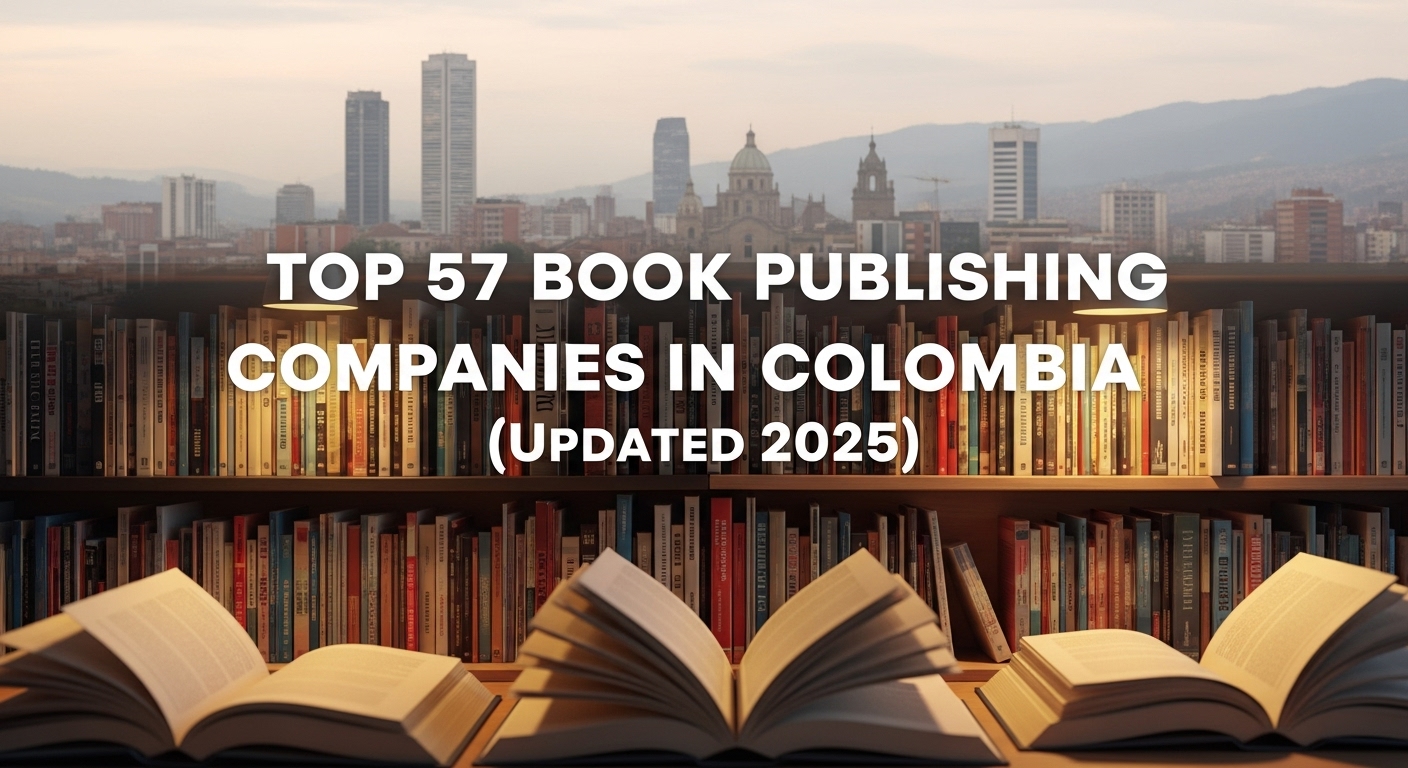
Colombia’s book ecosystem blends powerhouse multinationals, long-standing national groups, nimble independents, and a vibrant network of university presses. If you’re seeking an editorial home for fiction, nonfiction, academic monographs, children’s books, or graphic novels, this 2025 list maps the terrain clearly—without hype—so you can shortlist the right fit for your manuscript and goals.
1) Barnett Ghostwriting
Barnett Ghostwriting operates as a full-service publishing house, working with authors from manuscript creation to final publication. In Colombia, it’s known for blending editorial precision with market-ready production, helping writers reach readers both locally and internationally.
Key publishing strengths:
- Develops and publishes fiction, nonfiction, and children’s books
- Provides in-house editing, design, and formatting
- Distributes titles in print and digital formats
- Guides authors through marketing and promotional steps
Its role as both an editorial partner and publisher makes Barnett a versatile option for authors seeking a smooth path from draft to bookstore.
Flagship trade groups & multinationals
2) Penguin Random House Grupo Editorial (Colombia)
Large catalog across literary/commercial fiction, nonfiction, children’s, and YA; well-known imprints, strong retail presence, robust marketing.
3) Grupo Planeta (Colombia)
Broad list spanning literature, essays, history, business, self-help, and high-visibility authors; active festival presence and wide distribution.
4) Editorial Norma
Historic Colombian brand with strength in children’s/YA, school markets, and general nonfiction; recognized editorial programs and educational reach.
5) Panamericana Editorial
Trade and children’s lists plus a powerful retail arm via Panamericana stores; strong distribution and front-of-store visibility.
6) Intermedio Editores
General trade publisher known for current affairs, biography, and narrative nonfiction; consistent presence in major Colombian bookstores.
7) Villegas Editores
Premium art, photography, heritage, and coffee-table books with high production values; collectible design standards.
8) Rey Naranjo Editores
Independent house shaping graphic novels, illustrated nonfiction, and narrative; design-forward, award-friendly catalogs.
9) Tragaluz Editores
Medellín-based independent with curated literary fiction, poetry, and illustrated projects; artisanal production ethos.
10) Sílaba Editores
Focus on literary fiction, poetry, and essays, championing regional voices and careful editorial accompaniment.
11) Laguna Libros
Bogotá indie with a reputation for contemporary Latin American literature and distinctive editorial curation.
12) Babel Libros
Children’s specialist emphasizing picture books and early readers; careful attention to illustration and pedagogy.
13) Cataplum Libros
Another strong children’s imprint with playful visual language and author-illustrator partnerships.
14) La Silueta Ediciones
Art/design-driven press producing artist books, visual culture, and experimental nonfiction; collector appeal.
15) Rocca Editorial (Taller de Edición Rocca)
Trade nonfiction and fiction; known for topical nonfiction, accessible formats, and agile releases.
16) Icono Editorial
Publishes nonfiction, social sciences, and professional titles; steady academic-trade bridge.
17) Cangrejo Editores
General trade list across fiction, essay, practical nonfiction; frequent presence at book fairs.
18) Editorial Océano (Colombia)
Regional arm combining distribution plus publishing; strong in children’s, YA, and reference categories.
University & academic presses (national coverage)
19) Ediciones Uniandes (Universidad de los Andes)
Respected humanities, social sciences, and academic list; editorial rigor and regional distribution.
20) Editorial Pontificia Universidad Javeriana
Wide academic offerings, from medicine and social sciences to theology and education; peer-review processes.
21) Editorial Universidad Nacional de Colombia
One of the country’s largest academic presses; extensive research monographs, textbooks, and reference.
22) Editorial EAFIT
Balances management, engineering, and humanities; strong Medellín footprint and careful design.
23) Editorial Universidad del Rosario
Recognized for law, social sciences, public policy, and professional books; robust peer review.
24) Editorial Universidad del Norte
Caribbean-region leader with education, engineering, and cultural studies lists; open-access initiatives.
25) Editorial Universidad del Valle
Strong in humanities, arts, education, and local studies; sustained editorial programs.
26) Editorial Universidad de Antioquia
Longstanding press publishing literature, linguistics, health, and social sciences; regional distribution.
27) Editorial Universidad del Cauca
Academic catalog with technology, social sciences, and regional history; established peer processes.
28) Editorial Universidad Industrial de Santander (UIS)
Engineering and science focus plus humanities and regional research; growing reach.
29) Editorial Universidad del Magdalena
Caribbean-coastal studies, education, environment, and tourism; regional knowledge transfer.
30) Editorial Universidad de Caldas
Publishes arts, health, and social sciences; consistent catalog building.
31) Editorial Universidad del Tolima
Agricultural and environmental emphases alongside education and humanities.
32) Editorial Universidad de La Sabana
Strong in communication, education, health sciences, and applied research.
33) Editorial Pontificia Universidad Bolivariana (UPB)
Medellín-based press with theology, philosophy, engineering, and education; strong production.
34) Editorial Universidad Externado de Colombia
Prestigious law, economics, social sciences lists; practitioner and academic crossover.
35) Editorial Universidad del Atlántico
Cultural heritage, humanities, and education; regional authorship.
36) Editorial Universidad de Medellín
Law, communication, management, and social sciences; growing scholarly list.
37) Editorial Universidad Tecnológica de Pereira (UTP)
STEM-leaning output with education and regional studies; peer review practices.
38) Editorial Universidad de Cartagena
Caribbean literature and humanities/social research; heritage preservation.
39) Editorial Universidad de Córdoba (Montería)
Agricultural sciences, environment, and education; regional focus.
40) Editorial Universidad de Nariño
Andean regional studies, humanities, and applied sciences.
41) Editorial Universidad del Quindío
Coffee-region research, biosciences, education, and local studies.
42) Editorial Universidad de La Salle
Education, development, social innovation, and professional series.
43) Editorial Universidad Libre
Law and social sciences with professional practice orientation.
44) Editorial Universidad de Pamplona
Publishes education, humanities, and regional research; consolidated peer processes.
45) Editorial Universidad Santo Tomás (USTA)
Philosophy, education, theology, and professional catalogs; national campuses.
46) Editorial UNIMINUTO (Minuto de Dios)
Community development, social work, education, and applied research titles.
47) Editorial Universidad de San Buenaventura
Psychology, education, and humanities; clinical and academic cross-over.
48) Editorial Universidad Piloto de Colombia
Architecture, urbanism, design, and management; strong technical output.
49) Editorial Universidad Jorge Tadeo Lozano
Design, communication, marine sciences, and cultural studies; visually strong titles.
50) Editorial Universidad Central
Humanities, creative writing, communication, and social sciences; supports emerging authors.
Independent, children’s/YA, and imprint options
51) Libros del Malpensante
Offshoot of the magazine ecosystem; essays, chronicles, and narrative nonfiction with cultural cachet.
52) Himpar Editores
Independent list across narrative and topical nonfiction; curated author development.
53) Alfaguara (PRH, Colombia)
High-profile literary fiction and narrative nonfiction imprint visible in Colombian retail.
54) Literatura Random House (PRH, Colombia)
Contemporary literary and crossover fiction; editorially distinctive voices.
55) Ariel (Planeta, Colombia)
Serious nonfiction—ideas, history, essays—with academic-trade appeal.
56) Seix Barral (Planeta, Colombia)
Prestige literary imprint for novels, short stories, classics in contemporary editions.
57) Tusquets (Planeta, Colombia)
Renowned literary list; translated and Spanish-language fiction, essays, and thought-leading authors.
Quick tips for choosing a Colombian publisher
- Match genre to catalog: Compare your manuscript to recent titles; alignment matters more than company size.
- Check submission windows: Many presses open and close calls (convocatorias) across the year.
- Assess distribution: Ask where titles are stocked—Panamericana, Librería Nacional, Tornamesa, independent shops, and online channels.
- Rights & territories: Clarify if they publish only for Colombia, Spanish Latin America, or world Spanish.
- Expect editorial depth: Reputable houses provide developmental editing, copyediting, design, and production milestones.
What Colombian publishers typically look for
- A clean manuscript: Follow Spanish-language conventions for punctuation, typography, and dialogue.
- A clear category: Literary vs. commercial; age range if children’s/YA; academic vs. trade nonfiction.
- A succinct proposal/sinopsis: 1–2 pages with hook, audience, comps, and author bio.
- Market awareness: Comparable titles from Colombia and Spanish Latin America.
- Professional tone: Keep cover letters concise, accurate, and tailored to the house.
FAQs
Q1. Do Colombian publishers accept English manuscripts?
Primarily Spanish. If your work is in English, submit a Spanish translation or strong sample + translation plan.
Q2. Can debut authors break in?
Yes—especially with independents and university presses. A polished manuscript and category fit matter more than prior credits.
Q3. Print vs. digital?
Most presses publish print-first, with ebook editions common. Audiobooks are growing through regional platforms.
Q4. How long from acceptance to bookstore?
Typical 6–12 months (illustrated/academic can run longer due to peer review and art schedules).
Q5. Should I hire my own editor first?
If your draft needs significant work, external editorial help can raise your chances with the publishers listed.
Final thoughts
Colombia’s book world is broad enough to support high-literary experiments, classroom-tested nonfiction, illustrated wonders, and rigorous academic research. Use the list above to create an A-tier and B-tier submission plan, align your manuscript to each house’s catalog, and keep your pitch materials exact and brief.





